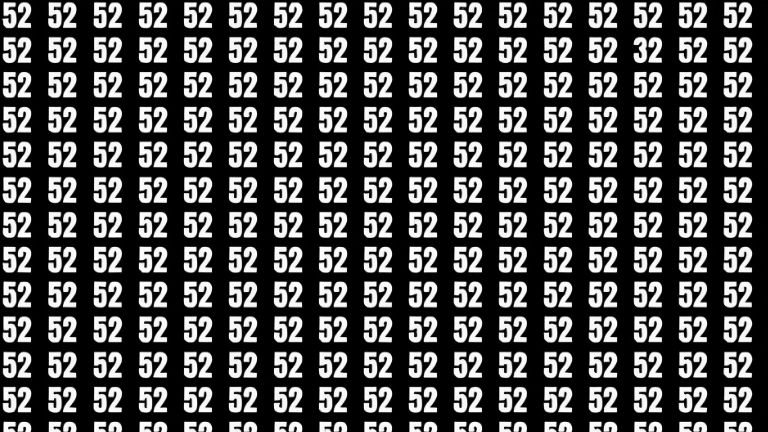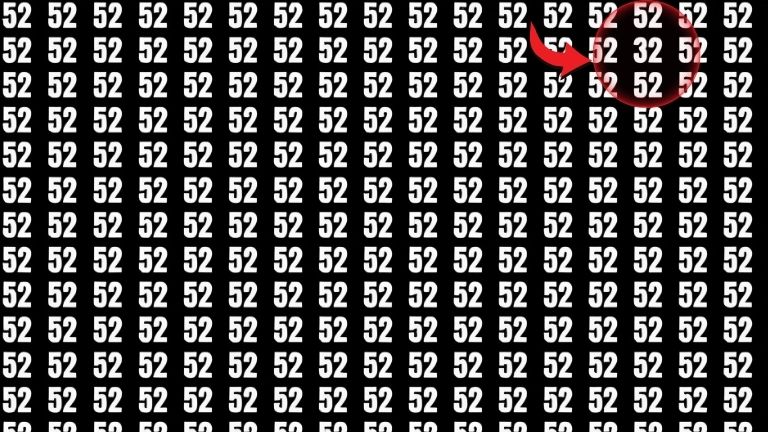The internet has gone crazy over a new optical illusion challenge that’s testing people’s vision like never before. This isn’t just another mindless scroll through social media – it’s a serious test of your mental sharpness and visual processing power.
Social media platforms are buzzing with users sharing screenshots and boasting about their success rates. The challenge seems simple enough, but don’t let appearances fool you.
The Viral Sensation Taking Over Social Media
This particular brain teaser has captured millions of eyeballs worldwide, and for good reason. People love challenges that make them feel smart, accomplished, or part of an exclusive club.
The premise is straightforward: find the odd number hidden among dozens of identical digits in just 4 seconds. Sounds easy? Think again.

What Makes This Challenge So Addictive?
Human psychology plays a huge role in why these puzzles become viral sensations. We’re naturally drawn to problems that seem solvable but require genuine effort.
The 4-second time limit adds pressure that transforms a simple visual task into an adrenaline-pumping experience. Your heart might actually race as you scan the image frantically.
The Science Behind Visual Processing
Neuroscientists explain that our brains process visual information through multiple pathways simultaneously. Some people naturally excel at pattern recognition while others struggle with similar tasks.
Individual differences in visual processing speed can vary dramatically between people. This explains why some folks spot the answer immediately while others never find it.
Breaking Down the Challenge Mechanics
Pattern recognition forms the backbone of this optical illusion challenge. Your brain must quickly identify subtle differences among nearly identical elements.
The difficulty level increases because the odd number often shares similar characteristics with the surrounding digits. A slight curve difference or missing line segment creates the variation.
Why 4 Seconds Makes All the Difference
Time pressure forces your brain to rely on instinctive processing rather than methodical scanning. This separation distinguishes naturally sharp observers from average viewers.
Research studies suggest that people with superior visual acuity can spot anomalies within 2-3 seconds of exposure. The 4-second limit allows for this natural advantage while still challenging most participants.
Common Strategies That Actually Work
Successful participants often report using specific techniques rather than random searching. Some scan systematically from left to right while others use peripheral vision.
Professional advice from eye specialists suggests starting from corners and working inward. This method reduces the overwhelming effect of staring at too many numbers simultaneously.
Understanding Your Brain’s Response
Cognitive load theory explains why this challenge feels mentally exhausting despite its apparent simplicity. Your working memory processes multiple visual elements while maintaining focus under time pressure.
Stress hormones can actually improve performance initially but become counterproductive if you feel too anxious. Finding the right balance between alertness and calmness is key.
The Role of Age in Visual Challenges
Younger participants often outperform older ones in these rapid visual tasks due to faster neural processing speeds. However, experience and patience can compensate for slower reflexes.
Studies indicate that people between ages 18-25 typically achieve the highest success rates. Yet many individuals in their 40s and 50s excel through superior pattern recognition skills.
Gender Differences in Visual Processing
Research findings show interesting variations between male and female performance on visual puzzles. Men often excel at spatial reasoning while women demonstrate superior attention to detail.
These differences aren’t absolute rules but statistical tendencies observed across large populations. Individual variation remains the most significant factor in determining success.
Training Your Eyes for Better Performance
Regular practice with visual puzzles can genuinely improve your performance over time. Like any skill, pattern recognition strengthens through consistent exercise.
Eye movement exercises recommended by optometrists can enhance scanning efficiency. Simple techniques like focusing on distant objects then switching to near ones improve flexibility.
Nutrition’s Impact on Visual Acuity
Dietary choices significantly affect your eye health and processing speed. Foods rich in omega-3 fatty acids and antioxidants support optimal retinal function.
Carrots aren’t the only answer – leafy greens, fish, and nuts provide essential nutrients for sharp vision. Proper hydration also plays a crucial role in maintaining peak visual performance.
Digital Screen Time and Its Effects
Extended screen exposure can temporarily reduce your ability to focus on fine details. The blue light emitted by devices causes eye strain that impacts performance.
Taking regular breaks from screens using the 20-20-20 rule helps maintain visual acuity. Look at something 20 feet away for 20 seconds every 20 minutes.
The Psychology Behind Viral Challenges
Social validation drives much of the sharing behavior around these optical illusions. People enjoy demonstrating their intelligence and visual skills to friends and followers.
FOMO (Fear of Missing Out) amplifies participation rates as users don’t want to be left out of trending challenges. This psychological pressure creates viral momentum.
Building Confidence Through Success
Completing these challenges successfully provides a genuine confidence boost that extends beyond the puzzle itself. This positive reinforcement encourages continued participation.
Failure can be discouraging but also motivating for determined individuals. Many people practice similar puzzles until they improve their success rates.
The Community Aspect
Online communities form around these challenges where participants share tips, celebrate successes, and support struggling members. This social element adds depth to simple visual puzzles.
Comment sections reveal fascinating insights into different approaches and strategies people use. Learning from others’ techniques can dramatically improve your own performance.
Technical Aspects of Optical Illusions
Color contrast and font selection significantly impact the difficulty level of number-based optical illusions. Designers carefully calibrate these elements to achieve desired challenge levels.
Resolution quality affects how clearly participants can distinguish between similar-looking digits. Higher resolution images generally produce more accurate results.
Creating Effective Visual Puzzles
Professional puzzle designers consider multiple factors when creating these challenges. The odd element must be different enough to be detectable but similar enough to require effort.
Testing phases with focus groups help determine appropriate difficulty levels. Too easy becomes boring while too hard leads to frustration and abandonment.
Cultural Variations in Number Recognition
Different cultures may show varying performance levels based on their familiarity with specific number fonts and styles. Arabic numerals are nearly universal but subtle stylistic differences exist.
Educational backgrounds influence how quickly people process numerical information. Those with mathematical training often excel at rapid number recognition tasks.
Health Benefits of Visual Challenges
Regular engagement with optical illusions provides genuine cognitive benefits similar to other brain training activities. Your visual processing speed can improve through consistent practice.
Memory formation strengthens as you develop better strategies for tackling these challenges. The problem-solving skills transfer to other areas of life.
Preventing Cognitive Decline
Mental stimulation through visual puzzles may help maintain cognitive function as we age. Neuroplasticity researchsuggests that challenging activities promote brain health.
Social engagement around these challenges provides additional benefits beyond the visual exercise itself. Discussing strategies and results with others stimulates verbal processing areas.
Stress Relief Through Focus
Intense concentration required for these challenges can provide temporary relief from daily stressors. The meditative aspect of focused visual scanning calms anxious minds.
Achievement satisfaction releases positive neurochemicals that improve mood and motivation. Successfully completing difficult challenges builds resilience and confidence.
Advanced Techniques for Success
Peripheral vision training can dramatically improve your performance on these optical illusion challenges. Practice expanding your visual field awareness through specific exercises.
Eye movement patterns developed by speed readers translate well to visual puzzle solving. Smooth scanning techniques prevent the jerky movements that cause missed details.
Breathing and Relaxation Methods
Controlled breathing maintains steady oxygen flow to your brain during intense visual concentration. Shallow breathing under pressure reduces cognitive performance.
Progressive muscle relaxation before attempting challenges can improve focus and reduce distracting tension. Physical comfort directly impacts mental performance.

Environmental Optimization
Proper lighting conditions significantly affect your ability to distinguish subtle visual differences. Natural daylight or high-quality LED lighting works best.
Screen positioning and viewing distance should be optimized for comfortable, strain-free viewing. Ergonomic setupprevents fatigue that could impact performance.
Frequently Asked Questions
Q: How can I improve my performance on these optical illusion challenges? Practice regularly with various visual puzzles and maintain good eye health through proper nutrition and rest.
Q: Why do some people find these puzzles easier than others? Individual differences in visual processing speed, pattern recognition ability, and attention to detail create natural variations in performance.
Q: Are there age-related factors that affect success rates? Yes, younger people typically have faster visual processing, but experience and patience can help older participants succeed.
Q: Can these challenges actually improve my eyesight? While they won’t correct vision problems, they can enhance visual processing skills and pattern recognition abilities.
Q: How long should I spend practicing these puzzles? Short, regular sessions of 10-15 minutes work better than long, intensive practice periods for skill development.
Q: Do these challenges have any educational value? Yes, they improve attention to detail, concentration, problem-solving skills, and visual processing speed.
Q: What should I do if I consistently fail these challenges? Consider eye health factors, practice easier versions first, and focus on developing systematic scanning techniques.
Q: Are digital versions as effective as printed ones? Digital versions offer advantages like adjustable contrast and size, but screen fatigue can be a limiting factor.
Q: Can children benefit from these optical illusion challenges? Absolutely, they’re excellent for developing visual discrimination skills and attention span in age-appropriate formats.
Q: How do I know if I have genuinely sharp eyes? Consistent success across various optical illusion types and quick detection times indicate superior visual processing abilities.